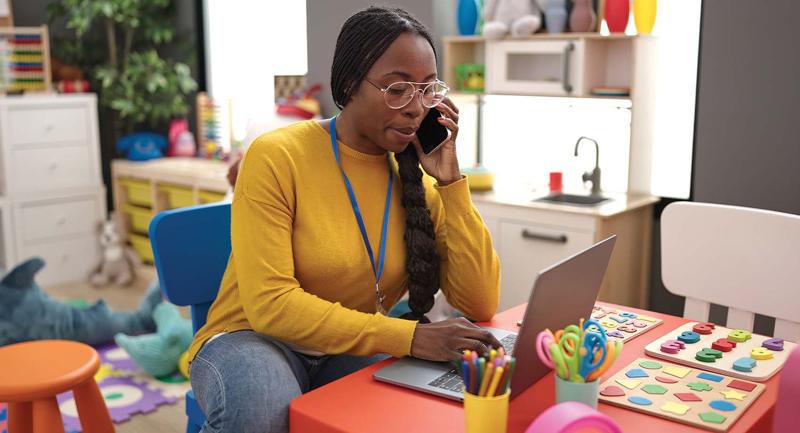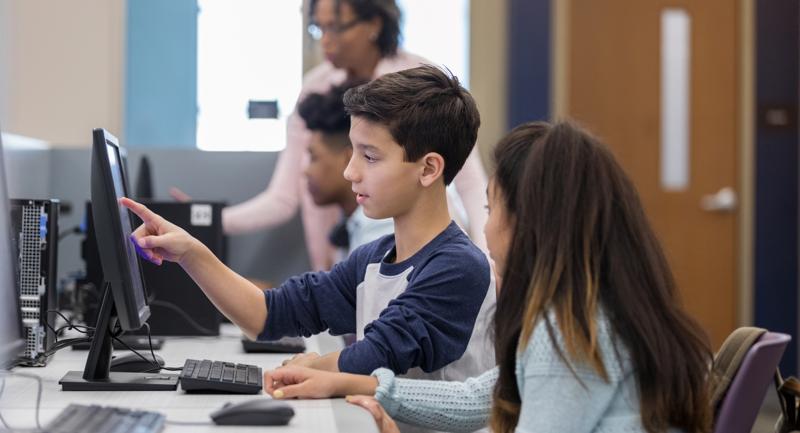We talk about change all the time in education—scores of books and articles are published on the topic every year. Policymakers push new initiatives and districts promote new curriculum, new structures, new models of classroom management, and new modes of instruction. Real change to what we do in schools seems to be endlessly desirable, but hard to enact.
When the world turned upside down last year with a global pandemic, educators experienced nothing but change. Additionally, and quite painfully, some of us saw the longstanding inequities of our systems in vivid color for the first time, moving many to wonder why schools, despite decades of shifts in policies and ideas, still weren't meeting their purpose of serving all students well. Some argue that we had a chance to make true change this year—and we missed the boat. Now that there is a vaccine and an end to (or at least a reprieve from) the pandemic is in sight, what's next?
My suggestions are drawn from a book I co-authored with Jennie Weiner called The Strategy Playbook for Educational Leaders and from the strategic planning work I do with district leaders, who wisely decided that creating a strategic plan was an opportunity to envision a more equitable future in light of all that has happened over the last year.
In education, we have come to think of strategic planning as an exercise that we undertake at predetermined intervals (perhaps yearly for a school improvement plan, perhaps every five years for a district strategic plan) in order to fulfill requirements imposed from outside—whether they come from the superintendent, the school board, or the state's department of education. Those plans are often written a) with the supervising entity in mind, and b) within the constraints of a required format—most often by filling out a template provided by the district or state. While many principals and superintendents can make the resulting plans work for them, planning is often performative rather than purposeful. This kind of plan is unlikely to produce real change, because principals and superintendents perceive the plan as an item to be checked off their to-do list rather than a thoughtful process that engages a leadership team and improves thinking and decision-making (Stevenson, 2019). The compliance-driven nature of planning represents a lost opportunity, even in ordinary times. But the treatment of planning as an event (going through the motions for the sake of creating a document) rather than as a process (strategic thinking about what goals should be and the strategy for reaching them—the why and the what) means that we leave out the tools already in existence to support planning and ignore the ways existing structures and systems interfere with efforts to improve student learning and increase equity.
What school communities need is a fresh vision as they figure out what to do next.
"Engage All Stakeholders"
This is a phrase we use all the time when developing strategic plans, but it's a target that we frequently miss. As early as possible in the process of envisioning what school is going to be like moving forward, enlarge the circle of people involved in the conversation. One of the corollary benefits of remote schooling is that many more people have experience using Zoom or its equivalent, and districts have accounts that allow hundreds of people to participate. Parents and community members who might not have been able to attend a meeting or focus group now can be present from their own homes.
Not everyone has a 4K screen or unlimited bandwidth, so we should avoid using tools that require a great connection or more than one window open at the same time. Almost everyone can use Google Meet or Zoom successfully from any device, but principals I work with have found that if we are going to use additional platforms like Google Docs, we should be sure to group participants in breakout rooms where we know someone will be able to take on the note-taker role.
More and more meetings are streamed live and/or recorded for later viewing, thereby increasing transparency. These expansions to community participation should be kept as a permanent feature of district planning. From a leadership and facilitation perspective, the ability to create a real-time transcript during a Zoom focus group or having stakeholders from across the district work in a small group and record their thinking opens up new possibilities for community engagement. It also gives participants the ability to engage both in real time or asynchronously and to hear from a greater diversity of voices.
Revisit the Vision
The disruptions to schooling have afforded a fresh look at what to include in a district vision. Many districts have already updated their vision statements with more precise descriptions of the knowledge, skills, and dispositions that they want their students to possess when they graduate, variously known as Portrait of the Graduate, Vision of the Graduate, Portrait of the Learner, and other similar variations. How students and teachers could and should use technology, how parents and teachers think about the essential skills students need, and how schools should address issues around racial equity and white supremacy continue to be lively discussions. Stakeholders have come to realize that "soft" skills like collaboration and communication and emotional self-regulation are not so soft when teachers and students cope with the challenges of online learning. Build Shared Understanding
There are so many opinions about what school closures have taught us and what that means for the future of schools. We tend to jump to solutions, disguise solutions as problems ("the problem is we don't have enough laptops"; "the problem is we don't teach SEL"; or "the problem is students don't have enough voice"), or set up solutions in competition with one another. Further, the way many of our institutions work encourages us to think in terms of lobbying for our own ideas, rather than stepping back and considering many suggestions and perspectives. Building shared understanding and agreement about what to aim for and how to move forward is to push back against this impulse. Develop a process that starts with clarity about what you are trying to achieve (the vision) and then asks, "How can we …?" The goal is to generate possibilities and reach agreements rather than stage a Hunger Games of ideas. Such a process, whether online or in person, involves asking individuals to think or write about their own values and ideas, to share those with others (in physical or virtual small groups), and to unpack assumptions and elaborate on the specifics before deciding to make a list of action steps (Stevenson & Weiner, 2021).
For example, one of the districts we work with has invested heavily in creating a shared understanding of what high quality instruction looks like. In order to build this, they invited a group of 5th and 6th graders to be part of a week-long experiment during the summer; they were taught by experienced math teachers who were willing to be observed by all the administrators in the district, plus two teachers from each school. After spending the morning in the classrooms, they came together to debrief what they had seen with the teachers and each other, to hear more about the district's focus on high-leverage instructional practices—such as scaffolding learning and giving feedback—and to plan how to lead for high quality instruction in their own schools. Such an intensity of focus on developing coherence around high quality instruction is rare but should be the norm.
Focus on the Positive
Deficit thinking is often a trap. Once we start noticing what's wrong, we can't help but notice other problems and concerns, and pretty soon everything seems hopeless. Optimism without strategy is just wishful thinking, but it's important to frame conversations in ways that tap into teachers' and leaders' confidence in their own knowledge and skills. Here are some examples:
Prompt people to think about their aspirations and best practices—what is the future we wish to create, and using what tools? To prompt those who are not as comfortable talking about their own successes, you might ask "What seems to have helped your students the most?" or "What useful practices have you borrowed from other teachers?" or offer an anonymous response option.
Don't spend energy documenting what students missed or what they can't do, unless you are very confident that this will lead to an intervention that will improve student learning. Instead, focus on what is most important in the upcoming curriculum, think about which curricular objectives to eliminate, emphasize, or combine, and be ready to scaffold instruction to support students. Pay attention to what Heath and Heath term "bright spots," also known as "positive deviants" (Sternin & Choo, 2000)—those who manage to outperform others, even when they have the same resources as everyone else. Which students seem to be doing well despite the challenges? What are their teachers doing to support them? Tap into the skills of special education teachers and English as a second language educators who have supported students with greater needs by including them in grade-level or department team meetings. This will be especially important now that all teachers have an increased obligation to scaffold their instruction. Creativity is not what matters most; improved outcomes for all students is what we should be focusing on.
Get Real About Change
I have seen a distinct tendency in improvement/strategic plans to underestimate what it will take to realize a vision. In other words, the creators of the plan seem to think that change is easier to bring about than it really is. For example, I have seen goals to increase the numbers of students who are successful in AP calculus classes and action steps that call for coaching and improvements in communication with families. But if I were to sit down with a group of teachers and asked them what it would take to improve the number of students scoring 4 or 5 on the AP Calculus test by a third, they would come up with a list of 15 or 20 necessary action items. For those who are hoping that education will look radically different next fall, writing and enacting plans to match the goals is difficult, technical work.
A useful tool for organizing this thinking is the driver diagram—a graphic organizer best used with small groups of mixed stakeholders (Bennett & Provost, 2015; Bryk et al., 2015). The diagram asks groups to specify what three or four changes are most likely to be needed to reach their goals (called primary drivers) and what it would take to enact those goals (secondary drivers). Going through such an exercise is more likely to generate realistic action steps for an ambitious goal. Capturing all the work that needs to be done is truly daunting. But all educators have experience with high-falutin' or sugar-coated initiatives that have come to nothing because we haven't created the capacity to enact them. When a community of students, parents and educators unite behind a powerful idea for what the future might hold, and they have a strategy to get them there, the possibilities are endless.







